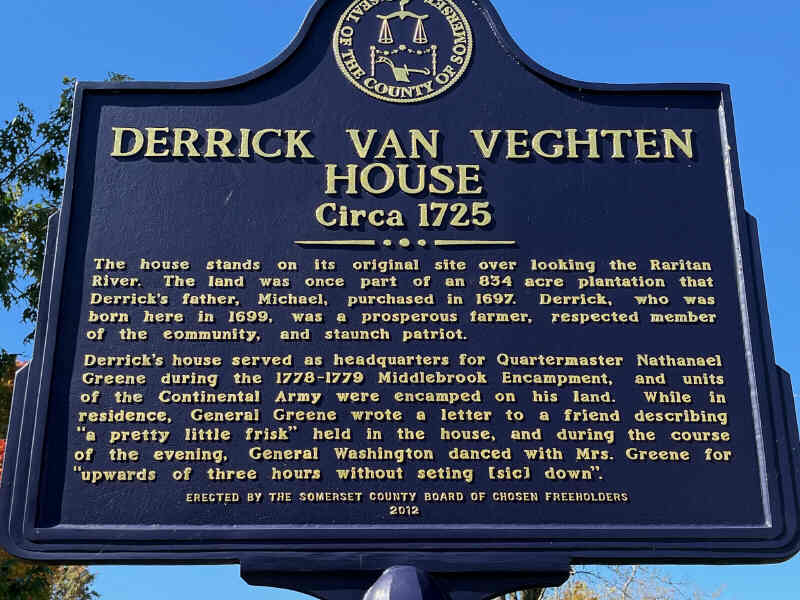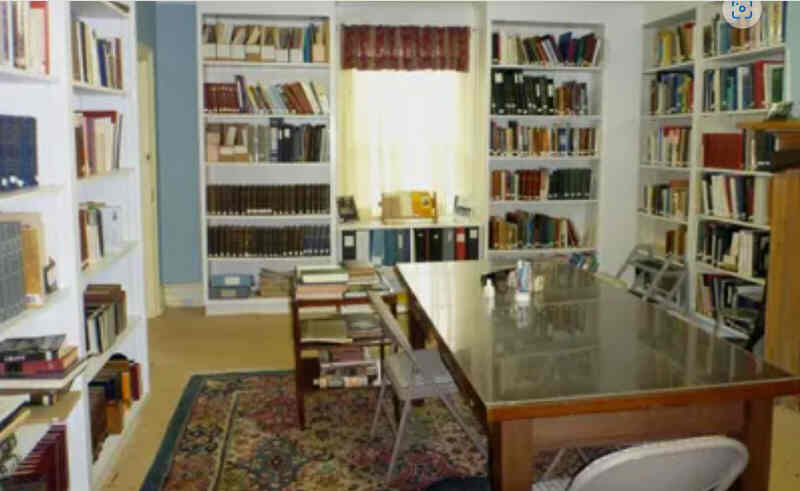
Today the house, with its one acre of land, sits in an industrial complex that contains mostly self-storage facilities and warehouse buildings.
This old house may not be socially prominent today, but in its early years the home, the owner, and the property were not only known throughout the area, but were in a sense “the area itself” as the Van Veghten farm consisted of 1.2 square miles. Here is their story.

While no map of his property is known to exist, references over time suggest that two-thirds of the property was to the north of the house and one-third to the south.
As for the east-west positioning, the house was around the center. So today the property border to the north would be as far as Route 28 and possibly Route 22. And the southern border would be in Manville, possibly as far down as the library, where there is an historical marker.

To support Derrick’s growing family, additions were made to the house. The first addition was a section off the original house consisting of one story. Later a second story was added on top of that. A line in the brick clearly shows the later addition of the second floor.
probably Grandson Michael

One surviving tax record shows 28 slaves, but for a farm that size there were likely more.
It is not known for how many decades that slaves were prominent but by the late 1830s, slavery was dying out due to the state’s gradual manumission laws and the fact that it was becoming socially unacceptable to have slaves.
 |
 |

Washington and his officers occasionally found time during the war for “socials” with music and dancing.
In fact, after one party in the Van Veghten house Nathaniel Greene would write in a letter that “his Excellency (George Washington) and Mrs. Greene danced upwards of three hours without once sitting down”. He concluded the letter by stating “upon the whole we had a pretty little frisk.”

Passing through the northern section of the farm was the Old York Road (today in Bridgewater the road is Main Street). This dirt road was the interstate highway of the era. Beginning in 1765 the Old York Road connected Philadelphia to New York City. The “Swift Sure Stage Line” advertised a two-day journey between the two cities.
This was a vital road. As travel by walking or horseback could be done on any road, wheeled vehicles could only travel on a few well-maintained roads. Wikipedia states that the Old York Road was the longest road in the era that could support wheeled vehicles.
The arch enemy of the roads was mud. Roads such as the Old York Road had to be graded as such to prevent water from accumulating. “Run offs” for water had to be carefully planned out and maintained. Having this road right at the Van Veghten farm was a tremendous convenience.

Michael Van Veghten established a Dutch Reformed Church on his property around 1730 across Finderne Avenue by the Raritan River. Unfortunately, in October of 1779 the British burned the church down when they saw that military supplies were stored in it.
With the Raritan River running through his property, it was important that a bridge over the river be built. The Van Veghten family did just that around 1733. The bridge was rebuilt in 1774. The bridge today connecting Bridgewater and Manville over Finderne Avenue is a descendant of the first bridge and is still known as Van Veghten’s Bridge. The bridge has been rebuilt/restructured perhaps five times.
As for the number of people who lived around here in the heyday of the Van Veghten Farm, records show that the population was just 5.8% of what it is today. (For Bridgewater the 1790 census shows the population was 2,578 – in the 2020 census the population was 43,968.)

The farm passed through different owners over the years.
In 1897, the Meyers Family purchased the property. Upon the death of Patriarch Bernhard Meyer, the inheritance taxes proved too much for the family and in 1934 most of the land was sold to the Singer Company. The days of the large farm were over. Singer used the land as an employee recreation area.
Years later an Industrial Park that remains today was established. In 1971, the house, with one acre of land, was deeded to the Somerset County Historical Society.

Besides the house itself, the Old York Road (Main Street), and the Bridge, there are two small graveyards that remain from the Van Veghten days.
Inside the property that makes up the Mount Pleasant Villas Apartment (located off Finderne Avenue south of Route 28) there are two gravestones. These are for Sarah Middaugh Van Veghten who died in 1785 and Eliza Berb Davis who died in 1795. A wooden structure (that does no justice to this sacred site) covers the gravestones. These gravestones are strangely horizontal to the ground and mounted in cement. They are freely accessible.

The gravestones were originally 200 yards west, but when Johns Manville, a former owner of the site, established a recreation area for their employees they were moved. This little cemetery is surrounded by a chain linked fence but is very visible. The access problem here is that it is the private property of a business that has restricted access.

They are open every Tuesday from 11 AM till 3 PM and the second Saturday of the month from noon till 3 PM. Admission is $5.